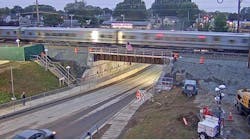MTA completes replacement of 108-year-old LIRR bridge in Garden City in 55 hours
The Metropolitan Transportation Authority (MTA) announced the completion of the replacement of the 108-year-old bridge that carries the Long Island Rail Road (LIRR) over Nassau Boulevard in Garden City; a higher bridge is now in place that will reduce track accidents, improve on-time performance and carry a third bay for expanding the railroad.
The bridge replacement was completed over a 55-hour window from the evening of Oct. 4 through 5:54 a.m. Oct. 7.
The bridge is the fifth major bridge or grade crossing project to be completed over the past 17 weeks along the LIRR’s Main Line as part of the LIRR Expansion Project. On June 1-2, the MTA replaced the LIRR’s Cherry Lane Bridge in Carle Place, and on Aug. 17-18, crews added a new bridge over S. Tyson Avenue in Floral Park. On July 20-21, crews placed a new bridge over Urban Avenue in New Cassel, replacing a previous an at-grade crossing, and on Aug. 24-25, crews placed a new bridge at the previous railroad crossing at Covert Avenue in New Hyde Park. The newly rebuilt roadway underneath is slated to reopen to traffic by Oct. 19.
“We have four more existing bridges to replace and six more at-grade crossings to eliminate over the next 35 months,” said MTA Chief Development Officer Janno Lieber. “The LIRR Expansion Project is moving forward at an extraordinary pace, which is why it is the model project for how we are changing the way we manage large capital projects to do them smarter, faster and better.”
LIRR President Phillip Eng added, “With each element of the LIRR Expansion Project that is completed our railroad gets a little bit healthier and less prone to potential challenges. Even before the third main line track is placed we are receiving benefit because raising the height of bridges prevents over-height trucks from striking the bridges, which creates train delays.”
The new bridge replaces a bridge dating to 1911 – the third year of President William H. Taft’s Administration – that was just 11 feet, 6 inches above the roadway. This was well below modern design standards, which made it prone to being struck by over-height trucks. The bridge had been struck 16 times in 2018-2019, and 43 times since 2010, making it the 3rd most-struck of all the LIRR’s bridges. The new bridge is two and a half feet higher – 14 feet – conforming with modern design standards to allow trucks to pass safely underneath.
The new bridge is 47 feet long, 39 feet wide and weighs 285 tons. It was assembled in a place adjacent to the site and crews inched it into place over this past weekend after first demolishing the old bridge. After the bridge was firmly set in place, LIRR crews rebuilt the track atop the bridge, reconnecting the existing two tracks. The bridge has a bay for a third track, which will be added in 2022 to expand the LIRR’s capacity, allow reverse commuting, and increase flexibility to allow the railroad to work around and more quickly recover from service disruptions.
